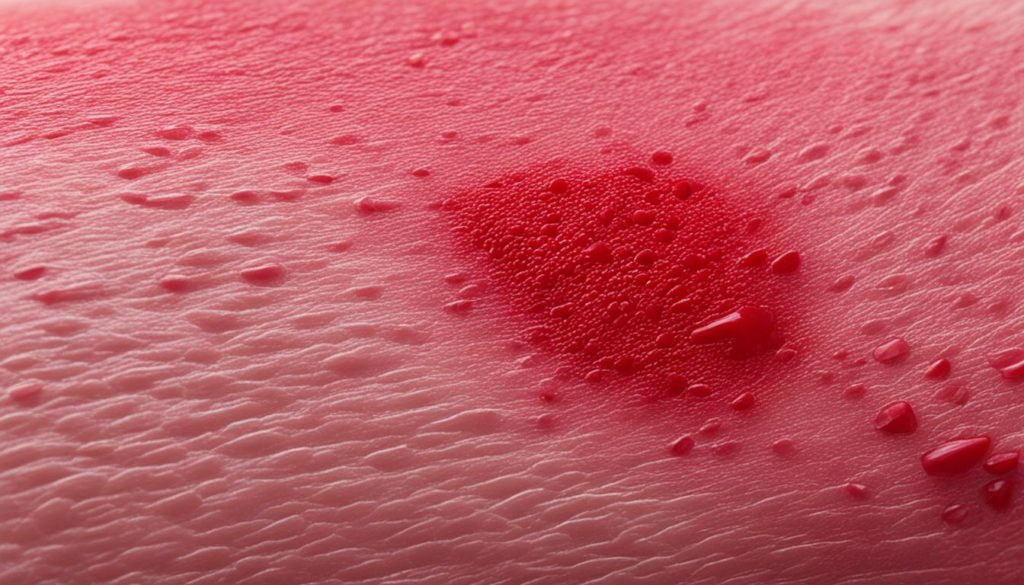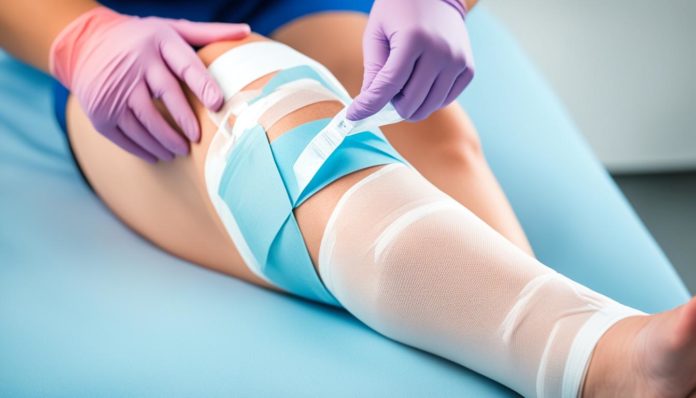Did you know over 14 million cases of cellulitis are diagnosed in the U.S. every year? This fact underlines the need to understand this common but serious skin infection well. Cellulitis, caused by bacteria, can get worse without quick treatment. So, it’s vital to know the causes, spot the symptoms, and get medical help fast.
In this article, we’ll look closely at cellulitis, starting with what it is. We’ll talk about how bacteria, like Streptococcus and Staphylococcus, cause it. You’ll learn about the signs that show you might have this infection. We’ll also cover the treatments for cellulitis, which include antibiotics and care at home. It’s important to know when to see a doctor. Lastly, we’ll talk about how to prevent it and what complications it can lead to. Our goal is to give you a full guide on keeping your skin healthy and avoiding cellulitis.
Key Takeaways
- Cellulitis affects over 14 million Americans annually.
- Early recognition and diagnosis are vital for effective cellulitis treatment.
- Common causes include bacterial infections, typically from Streptococcus and Staphylococcus.
- Symptoms range from initial redness and swelling to fever and chills in severe cases.
- Effective cellulitis management involves both medical treatment and home care strategies.
Understanding Cellulitis
Cellulitis is a common but serious bacterial skin infection. It affects the skin’s deeper layers and the tissue below. Bacteria like Streptococcus or Staphylococcus cause it. They get in through small cuts or breaks in the skin.

The legs often get infected, but cellulitis can appear anywhere on the body. It’s important to know that cellulitis doesn’t just affect the surface. It also harms the skin’s inner layers. So, spotting it early and starting treatment is key.
Want to know more about cellulitis information? If it’s not treated, this infection can get worse. It might lead to abscesses, spread throughout the body, or even cause sepsis. Learning about cellulitis is vital. It helps with quick action and prevents the infection from getting bad.
Causes of Cellulitis
Understanding cellulitis causes can help in prevention and early cure. It mainly comes from a bacterial infection entering the skin.
Common Bacterial Infections
The Streptococcus and Staphylococcus bacteria are often to blame. These germs get in through skin breaks like cuts or injuries. This can cause big swelling.

Risk Factors
Some people are more likely to get cellulitis. Risk-boosting factors are:
- A weakened immune system from illnesses or meds
- Chronic skin problems like eczema or athlete’s foot
- Having had cellulitis before
These factors make bacterial infections from streptococcus and staphylococcus more likely. And they can lead to cellulitis.
| Risk Factor | Description |
|---|---|
| Weakened Immune System | People with weaker immunity catch infections easier. |
| Chronic Skin Conditions | Issues like eczema offer bacteria more entry points. |
| Previous Cellulitis | Past cellulitis ups the risk of getting it again. |
Symptoms of Cellulitis
Spotting the symptoms of cellulitis early is very important. It helps prevent serious health problems. This skin infection has clear signs that we shouldn’t overlook.
Early Signs
At first, cellulitis might show mild symptoms. They can seem like small issues. Some early signs are:
- Skin redness in the affected area
- Swelling that goes beyond the red area
- Skin pain that feels tender and warm
- Discomfort that slowly gets worse
These initial symptoms mean an infection is starting. This makes fast action very important.
Progressing Symptoms
As the infection gets worse, the signs of cellulitis become clearer and more intense. People may notice:
- More skin redness spreading out
- More pain and tenderness in the skin
- Fever and chills showing the body is fighting the infection
- Red streaks moving from the infection site, showing it may be spreading
It’s crucial to catch and treat cellulitis early to manage it well.
Below, see how early and progressing symptoms compare. This helps with quick diagnosis:
| Early Signs | Progressing Symptoms |
|---|---|
| Skin redness | More skin redness |
| Swelling | More skin pain and tenderness |
| Skin pain | Fever and chills |
| Tenderness | Red streaks from infection |
How Cellulitis is Diagnosed
It’s vital to diagnose cellulitis correctly to start the right treatment. Doctors begin by doing a detailed medical examination. They look at your symptoms and medical past.
Medical Evaluation
In the medical evaluation, your doctor will carefully examine the skin area that’s affected. They check for redness, swelling, warmth, and pain. This step is important to tell cellulitis apart from other similar skin issues.
The doctor also asks about your medical history. This includes any recent injuries, surgeries, or health problems you might have. Knowing this helps figure out why you got the infection and your risk levels.
Laboratory Tests
Lab tests are crucial for confirming cellulitis. A blood test can show if you have an infection by looking at white blood cell counts. They might also do blood cultures to find the exact bacteria causing the issue.
For a skin culture, they take a tiny piece of skin from the affected area. This test finds out the specific bacteria responsible for the cellulitis. That way, your doctor can pick the best antibiotic to fight it.
| Diagnostic Method | Purpose | Details |
|---|---|---|
| Medical Examination | Initial Assessment | Evaluates symptoms and patient history |
| Blood Test | Confirms Infection | Detects elevated white blood cell counts |
| Skin Culture | Identifies Bacteria | Determines the specific type of bacteria causing the cellulitis |
Cellulitis Treatment Options
Treating cellulitis early stops the infection from becoming severe. The main treatments include medications and care at home. It’s also vital to know when to get medical help.
Antibiotic Therapy
Antibiotics are key in treating cellulitis. They fight the bacterial infection. Doctors often prescribe antibiotics such as:
- Cephalexin
- Dicloxacillin
- Clindamycin
- Trimethoprim-sulfamethoxazole
These antibiotics focus on the bacteria that cause cellulitis. They help lessen symptoms and stop the infection from getting worse. Remember, it’s important to finish all your antibiotics, even if you start feeling better.
Home Care
Home treatments can help heal cellulitis alongside antibiotics. Good home care tips are:
- Rest and Elevation: Elevating the affected part reduces swelling.
- Hydration: Drinking a lot of water helps remove toxins.
- Mild Exercise: Moving gently increases blood flow but shouldn’t hurt.
- Hygiene: Keep the skin clean and dry to avoid more infections.
When to Seek Medical Attention
Although many cellulitis cases can be treated at home, some situations require a doctor’s visit. Get medical help right away if:
- You get worse or don’t improve with home treatment
- You have a high fever or chills
- The infected area feels numb or changes color
- The infection seems to spread
Spotting these signs early and getting help can stop serious problems and effectively manage cellulitis.
Prevention of Cellulitis
Keeping your skin healthy is crucial to avoid cellulitis and its complications. To reduce risk, adopt effective cellulitis prevention strategies. One key aspect is looking after wounds properly. Clean any cuts or injuries well and cover them with sterile bandages until fully healed.
Good hygiene practices are also important. Washing your hands often and keeping skin clean help a lot. Also, protecting your skin is essential. Always wear appropriate shoes and gloves to avoid injuries that bacteria can exploit.
Those with diabetes or poor blood flow should take extra care of their feet and legs. Check them regularly for any infection signs. Keeping skin moisturized helps maintain a strong skin barrier. This reduces the chances of getting cracks that bacteria can enter.
Dealing with skin infections quickly is vital. Handle conditions like athlete’s foot right away to stop infections from getting worse. Knowing about these steps is powerful. It helps people make smart choices for their skin health.
- Clean any wounds immediately and keep them covered.
- Practice diligent hygiene practices, including regular hand washing.
- Regularly inspect feet and legs, especially for those with diabetes.
- Use moisturizers to protect the skin barrier.
- Treat superficial skin infections promptly.
Complications of Cellulitis
If not treated, cellulitis can lead to serious skin infections. These complications are dangerous and often need quick medical care. One serious complication is the infection spreading to the bloodstream, causing sepsis. This is a deadly reaction to the infection. The bacteria can also move to the lymph system, causing lasting swelling or lymphedema in the limb.
Another big worry is abscesses forming. These are pus-filled pockets that might need surgery to drain. Abscesses grow under the skin, causing more pain, redness, and swelling. In some cases, severe infections from cellulitis can attack the heart’s inner lining, known as endocarditis. This is especially true for people with heart problems already.
Cellulitis complications can also lead to repeated infections. Each new infection can worsen symptoms and weaken the skin against further issues. This happens a lot in people with weak immune systems or conditions like diabetes. It’s very important to keep an eye on things and take steps to prevent these problems.
In short, not dealing with cellulitis or severe cases can result in serious health issues. These include bacteremia, abscess, endocarditis, and ongoing swelling called lymphedema. Catching and treating cellulitis early is key to avoiding these dangerous complications.
Cellulitis in Special Populations
Understanding cellulitis in groups like children, the elderly, and those with diabetes is key. In children, it often starts from small injuries or insect bites. It can worsen quickly without fast treatment. Parents should look for signs like redness and swelling and get medical help early.
The elderly face cellulitis mostly because of a weaker immune system and other health issues. Their treatment needs extra care as their skin is delicate and heals slowly. It’s essential to ensure they receive the right care and monitoring in any long-term care settings.
Cellulitis is a bigger risk for people with diabetes due to poor blood flow and a lowered infection-fighting capability. Managing diabetes along with cellulitis requires careful blood sugar management and careful skin care. This helps in preventing further infections.
| Population | Common Causes | Treatment Considerations |
|---|---|---|
| Children | Minor injuries, insect bites | Early intervention, parental awareness |
| Elderly | Weakened immune system, co-morbidities | Careful monitoring, gentle treatment |
| Individuals with Diabetes | Compromised circulation | Strict glucose control, intensive skin care |
The Role of Nutrition in Cellulitis Recovery
Eating right plays a big role in healing cellulitis quickly. Including foods that boost skin health is key for a strong immune system and better skin repair.
For a good recovery from cellulitis, it’s vital to eat foods rich in certain nutrients. Here are some nutrition tips that could help:
- Hydration: Drinking plenty of water is critical. It flushes out toxins and keeps skin healthy.
- Vitamins: Vitamins A, C, and E help fix skin and boost immunity. Find them in citrus fruits, green veggies, and nuts.
- Protein-Rich Foods: Protein helps rebuild skin. Eat lean meats, beans, and legumes for a quick recovery.
- Minerals: Zinc and selenium are great for skin repair. Try seeds, seafood, and mushrooms.
- Antioxidants: Foods like berries, green tea, and dark chocolate are loaded with antioxidants. They help heal by fighting off damage to the body.
Knowing how nutrition and cellulitis interact shows why a balanced diet matters. Below is a list of skin-friendly foods:
| Nutrient | Benefits | Food Sources |
|---|---|---|
| Vitamin A | Makes skin cells renew faster | Carrots, sweet potatoes, kale |
| Vitamin C | Increases collagen | Oranges, strawberries, bell peppers |
| Vitamin E | Guards the skin | Almonds, sunflower seeds, spinach |
| Zinc | Boosts cell growth | Pumpkin seeds, chickpeas, oysters |
| Antioxidants | Lowers inflammation | Blueberries, green tea, dark chocolate |
Choosing a diet for skin health full of key nutrients is crucial for faster cellulitis recovery. Eating lots of vitamins, minerals, and antioxidants makes the body stronger and speeds up healing.
Conclusion
We’ve looked closely at cellulitis in this article. We’ve covered causes, symptoms, and treatments. Understanding what causes cellulitis and the risk factors is key. This helps with early spotting and preventing the disease.
Knowing early signs and how symptoms progress is crucial. It helps with fast diagnosis and managing the disease well. Getting diagnosed by a doctor and getting lab tests are very important. Treatment includes taking antibiotics, caring for yourself at home, and knowing when to get urgent help. All these steps help you recover quickly and avoid further issues.
It’s also vital to care for your skin and take steps to prevent cellulitis. Keeping clean, checking your skin often, and seeing a doctor if you spot symptoms are important. Taking care of your skin and knowing about cellulitis complications is part of a healthy lifestyle. This can help you avoid getting cellulitis again.
FAQ
What is cellulitis?
Cellulitis is a skin infection that’s quite serious. It makes the skin and tissues beneath it red, swollen, warm, and painful. If not treated quickly, it can spread fast.
What are the common causes of cellulitis?
Cellulitis often starts from bacterial infections. Streptococcus and Staphylococcus bacteria are the usual culprits. These bugs can slip into the skin via cuts or wounds.
What are the symptoms of cellulitis?
The signs include red and swollen skin that hurts. You might feel very tender in that area. If it gets worse, fever, chills, and red lines can appear.
How is cellulitis diagnosed?
Doctors look at your symptoms and history first. They might also do a physical check. Sometimes, they use blood tests and skin cultures to find the bacteria responsible.
What are the treatment options for cellulitis?
Antibiotics are the main way to treat it. You might take them by mouth or through an IV. It also helps to rest and keep the sore area up high.
Can cellulitis lead to complications?
Without treatment, it can get really bad. It might lead to sepsis, which is a blood infection, abscesses, or chronic swelling known as lymphedema.
How can cellulitis be prevented?
Keep wounds clean and skin healthy. Use moisturizer and treat any small skin infections quickly. For those with diabetes or bad circulation, check your feet and legs often.
Are there specific groups at higher risk for cellulitis?
Yes, kids, older adults, and people with diabetes are more prone to it. They might show different symptoms and need special care.
What role does nutrition play in cellulitis recovery?
Eating well helps you fight off cellulitis faster. Foods full of vitamins and minerals boost your immune system. Drinking plenty of water is also key.


